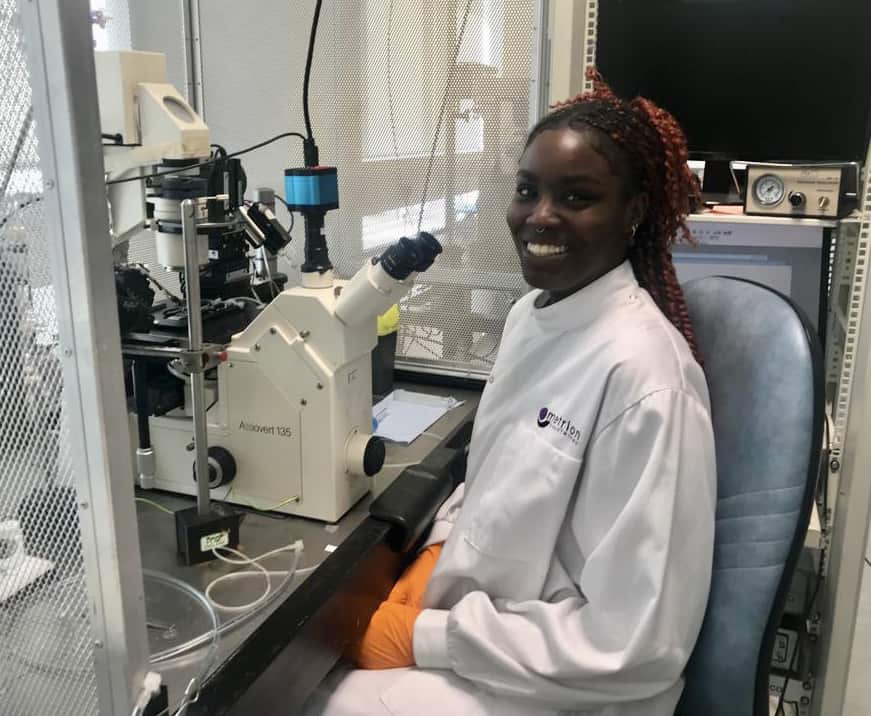Written by Faith Zarume
On 10th May , Metrion Biosciences and AstraZeneca co-hosted the annual Cambridge Ion Channel Forum, this year held at the Cambridge Building, Babraham Research Campus. Here, ion channel focused research was shared via a series of presentations, interspersed with networking opportunities. Before hearing from the six speakers, there was time to view the displayed posters, ask the authors questions, as well as catch up with some familiar faces.
First, we heard from Professor Alistair Mathie from the University of Kent on the future of potassium channels as therapeutic targets; predominantly focusing on human gene cloning, identification of channelopathies, and improving structural information on these channels. Professor Mathie began with a description of the role of potassium channels in humans and opportunities for therapeutic intervention. In order to characterise the pharmacology of potassium channels, he and his team studied KCNK9 imprinting syndrome, which is a monogenic disorder caused by an alteration in the maternal copy of the KCNK9 gene. It was found that mefenamic acid, a nonsteroidal anti-inflammatory drug allowed channel activity in a range of mutations where there was a gain or loss of TASK3 channel activity. Within 13,500 families involved in their work, 42% were given the satisfaction of a diagnosis. This research is aided using artificial intelligence (AI), such as the Alphafold protein structure database, which can provide predictions for protein folding.
Professor Mathie’s presentation was an excellent prelude to the talk given by Mr Sam Bourne (LifeArc) on genetic and functional validation of two-pore domain potassium (K2P) channels and their use in the treatment of pain related symptoms and disease, where there is great need for novel pain therapies. Through use of data, encompassing <120,000 K2P gene variants associated with distinct types of pain in both UK and Finnish populations, they were able to investigate the genetic impact of K2Ps in disease. There was a focus on TREK2 channel missense mutations and how this lead to an increased frequency of patients experiencing pain due to significantly reduced function – which was probed using a thallium flux assay.
Next, we heard from Dr. Oliver Acton, Senior Scientist at AstraZeneca. Oliver took us through how Cryogenic Electron Microscopy (CryoEM) has played a role in structure-based drug design with a specific focus on TRP channels. CryoEM allows for assessment of small molecule binding and collects data in just hours to then be processed in only a matter of days. With the help of CryoEM, Oliver’s group now have 320 TRP channel structures, captured in high resolution. Oliver presented an example where, in TRPA1, two antagonist binding sites can be seen, one closely located to the agonist binding site. This type of structural information can prove important in structural based drug targeting.
After a coffee break, with more time for networking and to study the posters on display, Professor Iain Greenwood from St George’s, University of London started off the afternoon session. He outlined ERG channels’ relevance in bodily locations, outside of the heart, such as in smooth muscle, allowing spontaneous contractile activity. Iain explained how ERG channels have been a key therapeutic target in studying hereditary arrythmias. Iain presented an example, where lack of effect of ERG channel blockers / activators was observed in the uterus of pregnant mice. This being determined by modification of KCNE2 proteins and their expression in the uterus, presenting altered physiological function. Other ERG channel responses have been explored in the bladder, portal vein, stomach and oesophagus.
Dr. Samantha Salvage from the University of Cambridge then detailed the implications for cardiac conduction from novel insights into Nav1.5α-β3 interaction, specifically the important role for the β3 extracellular immunoglobulin domain. Nav1.5 is heavily involved in cardiac action potential conduction and accordingly, mutations, including some β3 mutations, are known to pre-dispose individuals to arrhythmias such as Brugada and LongQT syndrome. Voltage sensor movement was observed using fluorescent tags and results indicated a loss of the extracellular domain that led to more negative potentials. Unique structural features of Nav1.5 account for differences in the α-β compared to other α subunits. For example, the presence of an N-linked glycosylation site (N319) on the Nav1.5 extracellular loop 3 influences β1 and β3 binding in a way that forces the Ig domains away from the core Nav1.5 structure and allow β1-mediated trans cell adhesion interactions.
The event was drawn to a close by Metrion Biosciences’ Dr. Alexandra Pinggera who presented on the success of endolysosomal patch clamp in investigating lysosomal storage disorders, such as Alzheimer’s and Parkinson’s disease, particularly when brought about by mutations in TMEM175 and TRPML channels in naïve HEK cells. It is usually necessary to introduce a mutation that traffics channels to the plasma membrane to utilise conventional patch clamp techniques. Additionally, acidic pH is required for operation of these channels and this cannot be easily regulated on the plasma membrane. But application of a refined technique aided in characterising endolysosomal ion channels in their naïve environments, allowing investigation into potential therapeutic agents. The presentation included a short video showing the lysopatch technique and the expertise required to gain a strong seal and make recordings.

